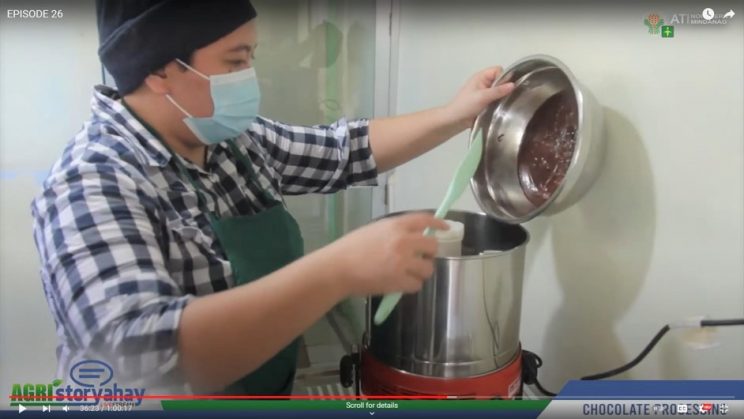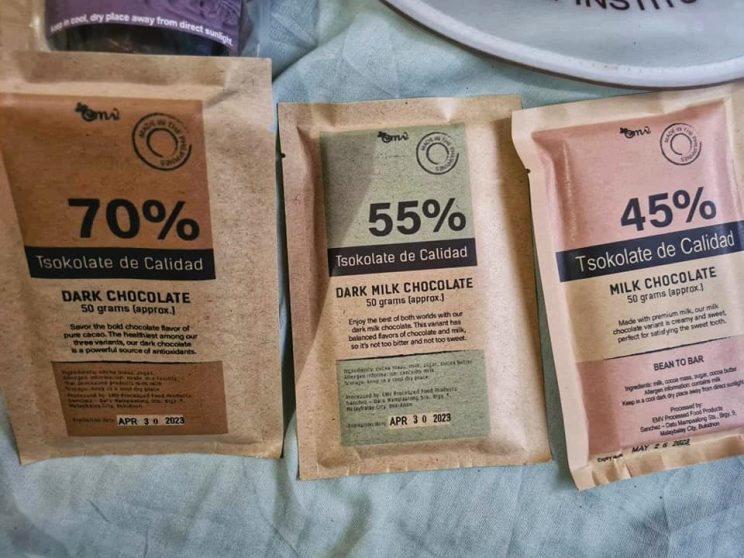By: Vic Thor A. Palarca
When Medily S. Villamayor decided to take a break from corporate life, little did she know that she would be sticking around in her hometown Malaybalay for a while.
Because part of her daily grind involves assisting her father, retired colonel turned farmer Edgardo M. Villamayor, with processing their farm’s produce like mangosteen and turmeric into consumable powders, the thought of processing cacao beans and turning them into sweet treats crossed her mind.

The experience in processing mangosteen prompted Med to self-study chocolate making by watching how-to guides on YouTube. She also did research work through the internet, after realizing that there is a growing interest and market demand in sourced cocoa and organic chocolates using single-origin cacao as the main ingredient.
In her one month respite at EMV Diversified Farm, the family’s certified Learning Site for Agriculture (LSA), the UP-Mindanao B.S. Applied Math graduate started making chocolates in 2018.
The early bars of chocolate were far from perfect, but it marked a start in her calling and career as a chocolatier. “Most of us got the idea how tableya is processed, I was quite challenged on how to come up with chocolates. It’s pretty much the same process, from the drying of the cacao seeds to grinding, but how is chocolate made?” Med says.
In a scheduled interview, Med shares her thoughts below regarding her sweet source of income.

What inspired you to venture in making chocolates?
“Ganahan ko ug chocolates. Wala man siguro tao nga walay hilig sa chocolate. Specially kadtong sa gamay pa ta. Ingon pa nila, 9 out of 10 ganahan ug chocolates, but one of them is probably not telling the truth. (I like chocolates. I think no one dislikes chocolate, especially when we were younger. As they say, 9 out of 10 likes chocolates, but one of them is probably not telling the truth.)
What did you find the most challenging about starting your own business?
The challenge was getting the right equipment since when I started, I was using the generic galingan (grinder) and then I saw on YouTube this thing called melanger, which gives off very fine and creamy cocoa paste. A chocolate melanger is a cylindrical device used to grind cacao beans and nibs to make cocoa paste (also known as chocolate liquor). This is an ideal kitchen tool for chocolatiers who want to make their chocolates super fine and extra smooth.
So I started making chocolates, but it was coarse from the get-go. It tasted “chocolatey” already but the look and mouthfeel is just like tableya with sweeteners on it. I personally wanted to have that chocolate experience the way we enjoy a store-bought chocolate bar.
I found out later on, that there is a difference in terms of consistency when availing the grinders in the local market from that of a melanger. I experimented on the percentage of sugar, cocoa concentration, the taste, and until such time that I got the right mixture and blend per bar.
At the moment, as the manager of EMV-Processed Food Products, I am the sole in-charge of making our chocolates. I have a helper who does the washing of the utensils and kitchen tools.

What goes into each bar of your popular gourmet chocolates?
In a nutshell, my process of making my chocolate bars start with the same process of producing tableya, but I just make it finer with higher standards. Then I add milk and sugar to make my bars creamier.
When making chocolates, I refine everything with a melanger. Then I add sugar, milk, and cocoa butter. Then it goes through the process of tempering and into the mold. I use a polycarbonate mold, but an ice cube tray or a thin sheet of silicon tray will do also.
What makes chocolate really good and fine to eat is through tempering with the use of a spatula and a scraper. Tempering is also known as slab or table method. A chocolate does not melt easily when it goes through the process of tempering. I noticed that the outcome is good when I temper my chocolates, and most of the bars I sent to trade exhibits are the ones easily sold out.
For now, I have three variants: 70% Dark Chocolates (percentage refers to the cacao content, no milk) 45% Milk Chocolate (the bestseller) and 55% Dark Milk Chocolate. They have a one year shelf life if processed right. The 14 grams are sold at 45 pesos each, while the 50 grams are sold at 100 pesos each.

What are the challenges and your marketing strategy to reach out to your customers?
On its initial outing, the marketing of the chocolate bars were done through word-of-mouth. Most of my mom’s officemates (Bukidnon State University college dean Mercidita S. Villamayor) in the academe or school visitors drop by at the farm and we let them have a free taste or offer snack during meetings and event giveaways. Other times, balikbayan friends and OFW colleagues would order my chocolate bars as pasalubongs. I still make bad bars due to the wrong temperature and timing, but I’m getting the hang of it. As the cliché goes, practice makes perfect.
Another challenge is to brace myself from questions of potential customers like ‘’nganong mahal imung chocolates?” (why are your chocolates expensive?) It’s a challenge to alter their mindset that what they pay for are premium chocolates worth their money. Good thing, the market demand for organic is growing since consumers are gradually getting aware of the health-risk of consuming alternatives compared to the real thing.
Can you share more about the real and fake chocolates you mentioned earlier?
I have learned from experts that there is real chocolate and fake chocolate. The real chocolates come from the cacao plant, from the ground cacao beans added with sugar and milk plus cocoa butter. You can tell by its aroma, texture, the snap, and the chocolateness that simply spreads into your mouth. The fake chocolate is composed of coconut oil and cocoa powder.
There is also a debate about white chocolates. Real white chocolate consists of cocoa butter plus sugar, plus milk. The cocoa powder was removed, and only cocoa butter was used. There is still a cocoa component though. You can call it chocolate when there is a cacao component.
In five years time, what can your customers expect from EMV Processed Food Products?
More food items and products. There is a plan to develop cacao wines, since I have already tried making banana wines on our farm. I saved the juice and within 6 to 12 hours it must be transferred to the fermentation bottles so that you can make them into wines. Unfortunately, for now, the harvested cacao pods in the farm aren’t enough to generate cacao juice to make wine. We can always buy or outsource wet beans though.
What advice do you give to those who want to turn their passion into business?
Do what you love doing. Give it a try first. Try farming. Try business. If it works for you, go for it. Go for that thing that sparks your interest. In my case, I did not intend to engage in business since I was eyeing to secure a corporate job. I started as Operations Research Analyst, then eventually, I did a lateral transfer to Systems Architect in a life insurance company. Then I resigned and figured out what to do next, something worthwhile my time and effort and something I enjoy doing.
Also, try to gather more information and skills. I was lucky and thankful for the Department of Trade and Industry (DTI) for their training on chocolate making. I enjoyed and learned so much since it was demonstrated through a hands-on process.
Aside from your own creations, what are your favorite chocolate products?
My chocolate of choice is either Meiji, Auro, or Theo and Filo. I lean towards the less sweet stuff, with the milk not overpowering the chocolate. Dark chocolates and sometimes milk chocolates, but not so sweet.
For more on chocolate making and cacao processing, watch ATI NorMin’s AgriStoryahay sa ATI Webinar Series – Episode 26 here: https://www.youtube.com/watch?v=xM3aUd8UuEs
Screenshots from ATI NorMin’s AgriStoryahay sa ATI Webinar Series – Episode 26
Source: https://mb.com.ph/2022/04/01/bukidnon-millennial-left-corporate-job-to-make-gourmet-chocolates-for-a-living/
